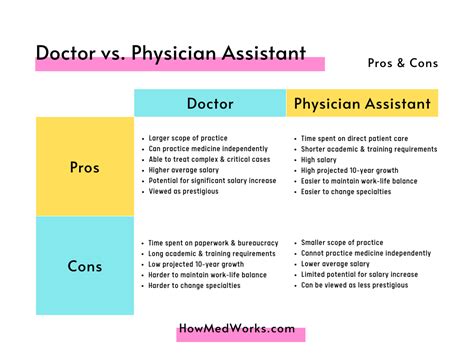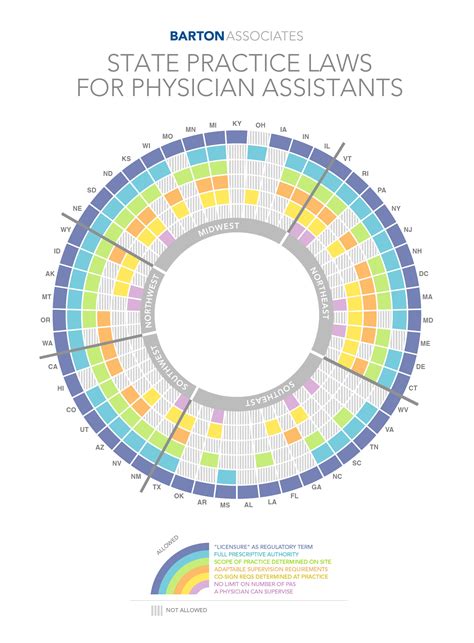Intro
Discover the key differences between physicians and physician assistants. Learn about their roles, responsibilities, education, and training. Understand the distinct career paths, salary variations, and work environments. Get insights into the autonomy, specialties, and patient care approaches of physicians and PAs, making informed decisions for your healthcare career or medical needs.
The healthcare industry has undergone significant changes in recent years, with an increased focus on providing high-quality patient care while managing costs. Two crucial roles in this sector are physicians and physician assistants (PAs). While both professionals play vital roles in delivering healthcare services, there are distinct differences between them. In this article, we will explore the differences between physicians and physician assistants, including their responsibilities, education, training, and scope of practice.

Physician Responsibilities
Physicians, also known as doctors, are medical professionals who have completed extensive education and training in diagnosing, treating, and preventing various medical conditions. Their primary responsibilities include:
- Conducting physical exams and taking medical histories
- Diagnosing and treating illnesses, injuries, and diseases
- Prescribing medications and therapies
- Ordering and interpreting diagnostic tests
- Developing and implementing treatment plans
- Providing preventative care and health education
Physicians can specialize in various fields, such as cardiology, oncology, or pediatrics, and work in hospitals, clinics, or private practices.
Physician Assistant Responsibilities
Physician assistants, on the other hand, are healthcare professionals who work under the supervision of physicians to provide medical care to patients. Their primary responsibilities include:
- Conducting physical exams and taking medical histories
- Diagnosing and treating illnesses, injuries, and diseases under the supervision of a physician
- Ordering and interpreting diagnostic tests
- Developing and implementing treatment plans under the guidance of a physician
- Providing preventative care and health education
- Assisting physicians during surgeries and other medical procedures
Physician assistants can work in various settings, including hospitals, clinics, and private practices, and can specialize in areas like primary care, surgery, or pediatrics.
Education and Training
One of the significant differences between physicians and physician assistants is their education and training.
Physicians typically complete:
- A bachelor's degree (4 years)
- Medical school (4 years)
- Residency program (3-7 years)
- Licensure and certification
Physician assistants, on the other hand, typically complete:
- A bachelor's degree (4 years)
- Physician assistant program (2-3 years)
- Certification and licensure
While physicians require more extensive education and training, physician assistants still receive comprehensive education and training in medical sciences, clinical practice, and patient care.
Scope of Practice
The scope of practice is another critical difference between physicians and physician assistants.
Physicians have a broader scope of practice, allowing them to:
- Diagnose and treat complex medical conditions
- Prescribe medications and therapies
- Perform surgeries and other medical procedures
- Order and interpret diagnostic tests
Physician assistants, while able to diagnose and treat medical conditions, work under the supervision of a physician and have a more limited scope of practice. They can:
- Diagnose and treat medical conditions under the supervision of a physician
- Order and interpret diagnostic tests under the guidance of a physician
- Assist physicians during surgeries and other medical procedures
Autonomy and Collaboration
Physician assistants often work autonomously, but they always maintain a collaborative relationship with physicians. This collaboration is essential in ensuring that patients receive high-quality care and that physician assistants can seek guidance and support when needed.
Salary and Job Outlook
According to the Bureau of Labor Statistics (BLS), the median annual salary for physicians is around $208,000, while the median annual salary for physician assistants is around $108,610. The BLS also predicts a 7% growth in employment opportunities for physicians and a 31% growth in employment opportunities for physician assistants from 2020 to 2030.
Challenges and Opportunities
Both physicians and physician assistants face unique challenges and opportunities in the healthcare industry.
Physicians face challenges like:
- Increasing administrative burdens
- Managing complex medical conditions
- Staying up-to-date with the latest medical research and technologies
Physician assistants face challenges like:
- Limited autonomy and scope of practice
- Managing the demands of a rapidly growing profession
- Maintaining collaboration and communication with physicians and other healthcare professionals
However, both physicians and physician assistants have opportunities to:
- Improve patient outcomes and quality of care
- Advance medical research and innovation
- Shape the future of healthcare policy and practice

Conclusion
In conclusion, while physicians and physician assistants share similarities in their roles and responsibilities, there are distinct differences between them. Physicians have a broader scope of practice, more extensive education and training, and higher salaries. Physician assistants, on the other hand, work under the supervision of physicians, have a more limited scope of practice, and receive less compensation. However, both professionals play vital roles in delivering high-quality patient care and have opportunities to advance medical research, innovation, and policy.
We encourage you to share your thoughts and experiences on the differences between physicians and physician assistants in the comments below. How do you think these roles will evolve in the future?
What is the primary difference between a physician and a physician assistant?
+The primary difference between a physician and a physician assistant is their scope of practice, education, and training. Physicians have a broader scope of practice, more extensive education and training, and higher salaries, while physician assistants work under the supervision of physicians and have a more limited scope of practice.
Can physician assistants prescribe medications?
+Yes, physician assistants can prescribe medications, but only under the supervision of a physician and within the limits of their scope of practice.
What is the average salary for a physician assistant?
+The average salary for a physician assistant is around $108,610, according to the Bureau of Labor Statistics.
